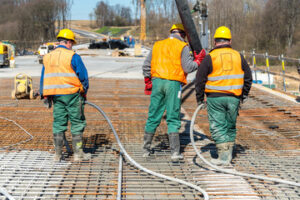A healthy lawn is an important part of a beautiful property. A full-service lawn care company can help maintain a lush, green yard.
Watering deeply and regularly, fertilizing appropriately, controlling weeds and pests, and aerating can all contribute to a lush, healthy lawn. It’s also essential to know the condition of your soil. A lab soil test can tell you the relative proportion of sand, silt, and clay in your soil. Click https://www.ltppropertymaintenance.com/ to learn more.

For grass to thrive and keep its green color, it needs to be adequately watered. Depending on the weather and soil conditions, sprinklers, irrigation systems, or hoses often do watering. Determining whether you are giving your lawn enough or too much water can be difficult. If you water too frequently, the roots do not grow as deep, and thiscan lead to many problems, including fungal diseases. If you water too little, the lawn will struggle to survive during hot weather.
Many factors go into determining how much and how often a lawn should be watered, such as the amount of sun or shade, the type of soil, temperature, and weather patterns. A good lawn care company will know how to best work with the weather and soil to ensure that the lawn gets the right amount of water.
A professional will also know to water early in the day, as this reduces evaporation and allows the lawn to dry out before evening, which can decrease the likelihood of fungal disease. They will also take into account upcoming rainfall and adjust the schedule accordingly to avoid overwatering.
If you are unsure whether your lawn is receiving the right amount of water, use a moisture probe to check the soil. The soil should be moist to the touch, but not muddy or damp down to the gravel or root zone. A healthy lawn will have a dark green color and feel spongy to the touch.
Other important aspects of lawn care include aeration, seeding or overseeding, mulching, and fertilization. Fertilization encourages healthy growth and helps resist diseases. Aeration is the process of pulling small cores out of the ground, loosening up the soil and allowing for better water infiltration. It can also help prevent thatch buildup, which smothers the grass, blocking its access to nutrients and oxygen. Mulching involves spreading a layer of organic material over the soil to retain moisture and reduce weeds. Finally, pruning involves the removal of dead or damaged branches and shrubs to maintain a neat appearance.
Fertilizing
Fertilizing is an essential lawn care service that keeps your grass green and healthy. It helps prevent weeds and promotes the growth of new grass, which makes your turf more resistant to external stressors. It also improves your property’s aesthetics, resulting in increased curb appeal and value for your home.
Lawn fertilizers contain essential nutrients such as nitrogen, phosphorus, and potassium. While most people associate the term “lawn fertilizer” with synthetic products, there are natural and organic options as well. The right type of lawn fertilizer depends on the specific needs of your turf, and your lawn specialist will recommend the best products for you.
Fertilizer is necessary for the health of your turf because nutrients are not always consistently present in the soil. The soil becomes depleted over time due to factors such as irrigation and rainwater, and it’s important to replenish these nutrients through fertilization.
Nitrogen in particular is an essential lawn care component because it provides the lush, vibrant color you desire. In addition, it’s a key ingredient in photosynthesis, which ensures that your grass stays healthy and aesthetically pleasing.
Your turf can only grow as fast and thick as its root system allows, so a proper balance of nutrients is required for optimal growth. Your lawn will benefit from regular fertilization throughout the year, but it’s especially crucial during peak growth periods. This is typically in the spring and fall for cool-season grasses, and in late spring or early summer for warm-season grasses.
Proper lawn care is a critical investment in your property. Not only does a verdant landscape increase the value of your home, but it also produces oxygen, filters dust and other airborne pollutants, and even absorbs sound, contributing to a quieter neighborhood. Additionally, a lawn that is well-maintained with proper fertilization and weed control can reduce erosion and runoff, which can help protect the environment and local ecosystems.
It’s easy to make the mistake of assuming that you can perform lawn maintenance yourself, given the wide array of lawn care products available at your local hardware store. However, you’re better off leaving the task to a professional to ensure that you’re using quality lawn fertilizers and weed control products.
Weed Control
Weeds not only spoil the appearance of your yard, but they can also be a serious safety hazard. They can cause uneven ground, clogged drainage systems and erode soil, leading to flooding and instability. Regularly removing weeds ensures your lawn is healthy and safe for people, pets and livestock.
The first step in weed control is to identify the specific weeds that are growing on your property. Different weeds require different methods for removal, and some can be very difficult to kill completely. A professional weed control service can help you determine the best approach to your individual situation and ensure your desired results are met.
Weed control is an important part of lawn care, as weeds compete with desirable grass for nutrients, water and sunlight. If left unchecked, they can eventually outgrow and choke out desirable plants, resulting in poor growth and weakening the overall health of your garden. In addition, some weeds are considered invasive species and can be extremely harmful to the environment, altering local ecosystems and outcompeting native plants.
Using targeted lawn care practices, including aeration and strategic mowing, can help suppress the growth of weeds by creating an inhospitable environment for them. Aerating the lawn helps to break up soil compaction, allowing air, water and nutrients to reach grass roots more easily. This can reduce the need for chemical herbicides and promote a dense, strong turf that naturally inhibits weed growth.
Another way to prevent weeds is by applying a liquid or granular weed killer in the right conditions. The right conditions include moisture, as weed killers work best when the leaves are wet. In addition, the warm temperatures of spring and summer are ideal for application of these products.
Many lawn care professionals have a variety of weed killing products in their arsenal, from generic to specialty formulations. They also know the exact times of year to apply these products for maximum effectiveness. Professionals also have commercial licensing that allows them to purchase the highest quality products, many of which are not available for retail sale.
Pest Control
Lawn pest control is one of the most important aspects of a comprehensive lawn care regimen. When pests like grubs, chinch bugs, lawn weeds, and aphids are allowed to go unchecked, they can damage the grass and create unsightly and unhealthy patches of bare or damaged turf. A professional lawn care specialist can help you protect your investment by implementing preventative treatments that will limit the growth of these unwanted guests.
Some pests can be controlled with consistent mowing, watering and fertilizing practices, but others require more targeted intervention. For example, if an aggressive weed like dollar weed or clover has invaded your yard, it may need to be treated with a weed killer that can target specific plant types without damaging other varieties. A lawn care specialist can develop a treatment plan to manage these problems while prioritizing long-term lawn health and environmental stewardship.
In addition to implementing preventative lawn care measures, professional landscapers can also use integrated pest management (IPM) methods to minimize the need for chemical treatments. These techniques combine cultural, mechanical and biological control strategies that discourage the development of pest resistance to insecticides. Some of these methods include removing weeds from the soil, limiting water-dependent plants, establishing proper plant placement in your landscape to reduce pest sheltering and feeding spots, promoting adequate drainage to limit standing water, and removing dense shade that limits the health and vigor of grasses.
Regular inspections of your lawn will alert you to signs of a pest infestation before extensive damage can occur. Look for bare or patchy patches of lawn that are discolored or dead, and pay special attention to those with an uneven surface. Digging or cutting beneath the thatch layer of your lawn can also reveal pest activity. In some cases, a pest problem can be identified by the presence of tunnels or mounds created by rodents or other burrowing pests. If you see these or unexplained damage to your lawn, schedule an appointment with a professional lawn care specialist as soon as possible. This will ensure that your outdoor space stays healthy and beautiful all year round.








